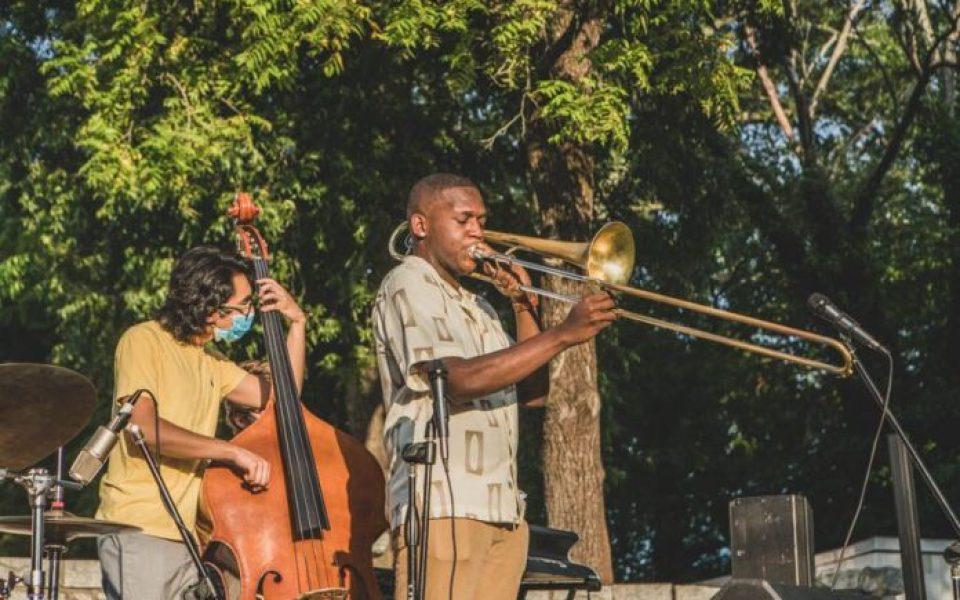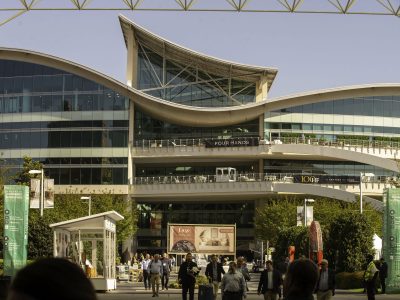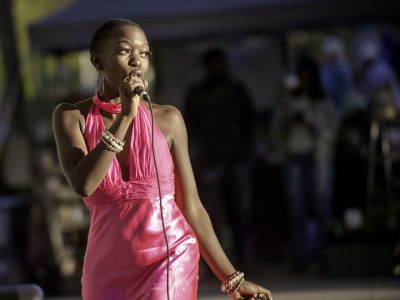Featured photo: The Leroy Pridgen quartet performs on stage at the Historic Magnolia House (photo by Carolyn de Berry)
The smell of freshly fried chicken hangs heavy in the humid summer air as Demeanor begins to strum the strings on his electric banjo. The plinky-plunky sounds of the instrument mingles with chirping cicadas as the sun sets beyond Plott Street in Greensboro, illuminating the Bennett College water tower. The light is golden.
“Tell ‘em how the banjo is Black!” yells activist April Parker from the lawn behind the Historic Magnolia House, where dozens have gathered for a socially-distanced outdoor concert. The event on Saturday evening served as a fundraiser for the historic building, which was included as a stop in The Negro Motorist Green Book during the Jim Crow years.
Demeanor, aka Justin Harrington, an activist and musician based in Greensboro, helped put the set list together for the evening’s event.
He explains to the crowd on the lawn, as well as those listening to the concert from their cars and at home from their laptops, that the origin of the bluegrass instrument comes from enslaved peoples in the Caribbean and in Africa.
“The banjo has its ancestry in Africa with instruments like the akonting,” he says, “and the type of banjo that I play was basically what happened when Americans picked up what the banjo is.”

Demeanor’s set runs the gamut from banjo music infused with Egyptian chords to jazzy folk accompanied by the lyricist’s seamless rapping. And as the night goes on with more Black artists like J. Timber, Debbie the Artist and the Leroy Pridgen quartet taking the stage to showcase their talents, viewers are given a taste of what might have been like for Black artists and musicians like James Baldwin and Sam Cooke when they stayed at the house decades ago.
“It feels good because they’ve supported Black artists for so long,” Demeanor says about the house. “So, it’s nice to be able to support them.”
The house, owned and run by Natalie Miller and her father Samuel Penn Pass, closed its doors in March when the pandemic took off and reopened to the public for the first time on Saturday. Miller has been hosting jazz brunches at the house, and hopes to eventually restore it to an exact replica of the 1940’s Green Book bed and breakfast. She says they’ve struggled financially because of the pandemic, and that people in the community still don’t seem to recognize that the house is there and the significance of the structure’s history.
“We’ve tried over the last couple of years with the community to try to get them to join the Magnolia movement,” Miller says. “Tonight, I feel like everybody has wrapped their arms around this house. It’s the community that needs to help build this house with me.”

As attendees enjoy the live music, they also eat shoebox meals which Miller says are reminiscent of meals that Black mothers would make for road trips during Jim Crow. Foods that would last like fried chicken, devilled eggs and pound cake were the norm, and are also seen in the boxes tonight.
April Parker, the organizer for the event, says she wants to see the Historic Magnolia House become a Black cultural institution again.
“Like after church, I want people to be like, ‘Are you guys going to Magnolia for a drink?’” she says. “I want it to be a part of the ritual here. I want it to be a meeting place. I want it to feel like home. It’s such a prime location. It’s within the neighborhood…. I want it to be a staple in our community for years to come. Outside of churches and the Beloved Community Center and the Civil Rights Museum, Black folks don’t really have a space we can say that is created at the root of blackness.”
Parker who has been working with Elsewhere to put together events throughout the city, including the concert at Magnolia, says that as part of her fellowship, she wants to be an architect of Black space.
“I’m really thinking about Black women as the pillars of the community and our porches and our kitchen tables as institutional structures that we have as Black power,” Parker says.
She says she rejects the notion of a “sharecropping mode,” in which artists are paid by community institutions but aren’t given platforms to have real power or a voice.

“It’s using Black artists and using a very monetary exchange,” she says. “It’s like, ‘We’re going to give you a small amount of money and we’re going to build social and political capital off of it.’ That doesn’t give us real equity. Post Covid and post uprising we need to talk about, ‘How can we push towards equity?’”
Parker, who has long been a community activist in Greensboro, recognizes that art and protest and Black power all intersect and exist simultaneously. Many of the musicians and artists involved with the event on Saturday marched in Greensboro during Black Lives Matter protests in the weeks after George Floyd’s murder.
Virginia Holmes, who led some of the earlier protests works with Emilio Marz on painting a trailer near the stage. Vibrant curls of pink and purple act as a background for large, flowering magnolias painted in a street art style.
-

Artist Virginia Holmes paints a mural at the event. (photo by Sayaka Matsuoka) -

Artists Virginia Holmes and Emilio Marz paint the mural. (photo by Sayaka Matsuoka)
Nearby, Mutsa Mukahanana, an attendee at the concert who sits on the roof of her car as she listens to the concert, says she found out about the event because of her connections to the protests.
“I didn’t know Greensboro had a place like this,” she says. “I think its history is important to preserve because of the Black lives that it has saved. There’s not enough Black stuff for this to not be preserved.”

As musicians come off of the stage, Demeanor works to keep the audience engaged while the next artist sets up. He issues a repeated call and response for the crowd, one that’s less of a reminder, and more of a declaratory statement of celebration.
“Black is beautiful,” he says.
“Yes indeed.”
“Magnolia is beautiful.”
“Yes indeed!”
“You all are beautiful.”
“Yes indeed.”
Learn more about the Historic Magnolia House at thehistoricmagnoliahouse.com and watch the full concert on their Facebook page.
Join the First Amendment Society, a membership that goes directly to funding TCB‘s newsroom.
We believe that reporting can save the world.
The TCB First Amendment Society recognizes the vital role of a free, unfettered press with a bundling of local experiences designed to build community, and unique engagements with our newsroom that will help you understand, and shape, local journalism’s critical role in uplifting the people in our cities.
All revenue goes directly into the newsroom as reporters’ salaries and freelance commissions.





Leave a Reply